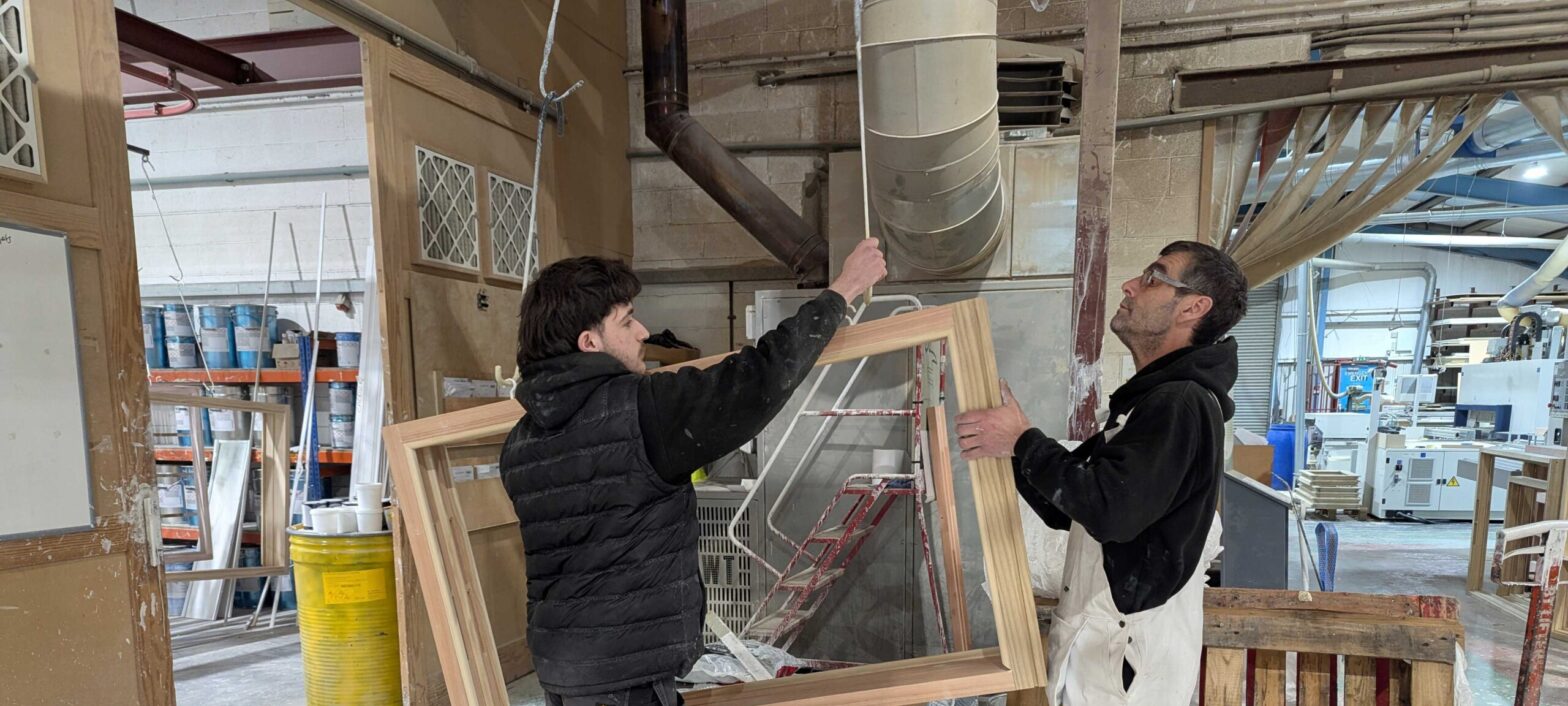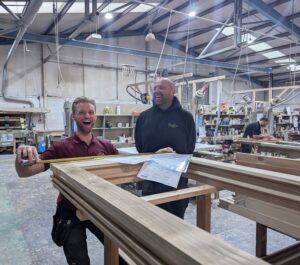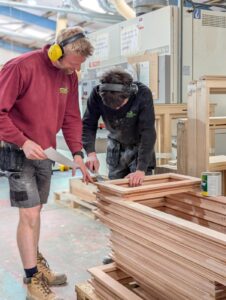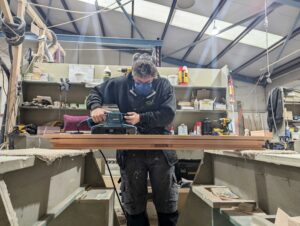
Apprenticeships and the Future of Joinery
Apprenticeships and the Future of Joinery
Amy Boutle, Marketing Manager at Gowercroft Joinery, discusses apprenticeships, and in her opinion, what the future of joinery looks like.
As a country, we have already done it. We have hurled ourselves off the cliff, lemming-style.
The construction workforce is ageing fast: A quarter are already over 55, heading towards retirement in what is a physical industry. Apprenticeship completions have also fallen sharply, with little more than half of construction apprentices actually finishing their training.
The problem is not creeping towards us. It is already here. Now, the question is how we climb back up.
Why apprenticeships fail too often

On paper, the Bench Joiner apprenticeship looks strong. It covers tools, drawings, materials, tolerances, health and safety, and machine use. But paper is not the real world.
Too many apprentices are treated as cheap labour, given menial tasks and left without proper guidance. Training days at college are often seen as a nuisance rather than an investment. And unsurprisingly, many drop out.
Roy, now Assembly Supervisor at Gowercroft, explained how his first apprenticeship felt: “Back in the day I just felt like it was part of the job…you’re the lowest of the low so you just take what everyone gives you who is above you. But now I know that’s not true.”
Cody, another of Gowercroft’s apprentices, pointed out that those stereotypes still hang over apprenticeships today: “I hate it when people say, ‘Oh, you’re going to be cleaning the toilets as an apprentice.”

Part of the problem is, that in some places this is still true and it’s a story we hear to often from those joining the company. And this culture doesn’t just discourage people. It hits hardest for those who need more tailored support. Learners with learning difficulties or disabilities already make up around 15.6% of apprenticeship starts in England. But that only counts diagnosed cases. The real figure is higher, given multi-year waiting lists for ADHD and dyslexia assessments.
And, many who prefer practical work are more likely to be neurodiverse in the first place. Yet, the understanding in many workplaces is lacking in this area. A fixed idea of a what makes a “good employee” can drastically undervalue other qualities and being able to adapt to support different types of learner takes a level of understanding that most don’t have without education.
Quality training must recognise different needs: apprentices may require reasonable adjustments. Without them and an understanding of what the right ones are, apprentices with it makes sense that those with unmet needs would struggle more and withdraw.
The system is not helping

Policy changes are making things worse, not better. From 2025, apprenticeships can last as little as eight months. Common sense dictates that less time learning means less depth of knowledge. The logical result is more workers who can do the basics, but not the problem solving or innovation that come from mastering a craft.
Also, funding is also being diverted away from higher-level apprenticeships. The message is clear: university is for the “clever” children, while trades are a fallback. Add to that the rule that apprentices over 19 must be paid the full minimum wage for their age after year one, and businesses start questioning whether they can afford to take anyone on at all.
Even here, we have had those debates. Finance and production both raised the cost calculations. We chose to carry on because training is such an essential part of who we are, but many businesses cannot afford to make choices based on business morals. A system based on expecting businesses to do things based on the goodness of their hearts and make a loss is never going to work.
Skipping around before settling
Symptomatic of a lack of early encouragement, apprenticeships are rarely a first choice.

We’ve seen it at Gowercroft. Alfie tried plumbing and catering before finding joinery. Roy left the trade altogether after a toxic apprenticeship and only returned years later. Lilli, who eventually joined for an Administrative Apprenticeship before rising quickly through the ranks spent an extended stint at McDonalds first. Her talent was so clear that we made her Partnerships Manager before her apprenticeship even finished and she won BWF Apprentice of the Year.
It’s not a lack of talent, rather a confused sense of direction.
That pattern is common. By the time apprentices arrive, they are older, cost more to employ, and are less likely to have their training fully funded. Imagine the difference if they came straight from school:
- Skills gained sooner
- Businesses supported by full funding
- More financial viability because minimum wage rises kick in later
Right now, the system makes it harder, not easier, to recruit the very people we need most.
What good looks like

Phil Yarde, a tutor at West Notts College, sees the difference employer culture makes: “Apprenticeships are vital for securing the future of traditional skills like joinery, and businesses such as Gowercroft are leading the way.
“By training apprentices, they not only strengthen their own workforce but also safeguard high-quality craftsmanship for the future. What sets Gowercroft apart is the outstanding support given to apprentices. They are mentored by skilled craftspeople, given real responsibility, and encouraged to grow both technically and personally.”
Roy now mentors now apprentices himself, with more than just technical skills in mind. Drawing on his own bad experiences he works to build build a positive culture: “It’s not just about teaching joinery. It’s about making sure apprentices grow as people. If they’re nervous or anxious, they need to know they can come to me. I adapt how I support them, because not everyone learns the same way. My job is to make sure they never feel the way I once did.”
And that impact is felt by Gowercroft’s learners. Alfie, explained: “When I first used a belt sander, I just left it running on top of a sash and burnt a hole. They laughed, but then they showed me how to do it properly. Here, I’ve had real support: answers to my questions, the chance to try things, and the experience you can’t get in a classroom.”
Cody, feels the positive impact too: “I was timid when I started, but I found myself opening up to colleagues. They encouraged me to try things, and now I can use almost every machine. I’ve learned more than I could ever ask for.”
That is what apprenticeships should be: not box-ticking, but proper learning backed by patience, skill, and encouragement.
The future we need
Apprenticeships cannot remain a Plan B. Starts for young people have been falling, while starts for older learners increase. If that trend continues, the skills pipeline narrows even further.
The future has to look different:
- Schools must promote trades as smart first choices and we must work with them to do it
- Government must make apprenticeships affordable for employers
- Training should be given to those in business responsible for supporting apprentices – particularly about different ways to learn and accessibility
- Wages for skilled trades must reflect their true value and funding should be provided to subsidise the wage cost of apprentices, not just the training
And as a country, we must stop pretending rote memorisation is “clever” while creativity and problem-solving are somehow second-class.

At Gowercroft Joinery, we know the answer lies in people. We are proud members of the 5% Club, yet we far exceed that benchmark with over 15% of our workforce in training. Because of our commitment and training, many have gone on to win awards and occupy senior positions. This commitment also keeps our workforce loyal, like Ross who recently celebrated 20 years with us. He started as an apprentice and now supervises our Machine Shop.
That is not charity. For us, it is common sense and the way that we are futureproofing our business.
Want to hear more about the individual stories of our apprentices? Click the links below.
Roy: https://www.youtube.com/watch?v=mF7i6BIMTQs
Cody: https://www.tiktok.com/@gowercrofttimberwindows/video/7541048749615779094
Alfie: https://www.tiktok.com/@gowercrofttimberwindows/video/7546219485544467734
Lilli: https://www.tiktok.com/@gowercrofttimberwindows/video/7426338467031911713
Or for more information about Gowercroft Joinery, visit: Timber Windows – Heritage Windows – Gowercroft Joinery
More news

“Construction coalition” warns against apprenticeship reforms plans

George Joyce Receives Graham Kirkham Award
